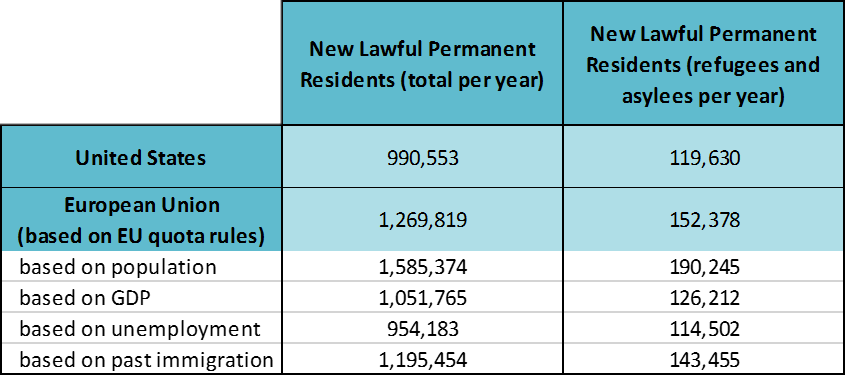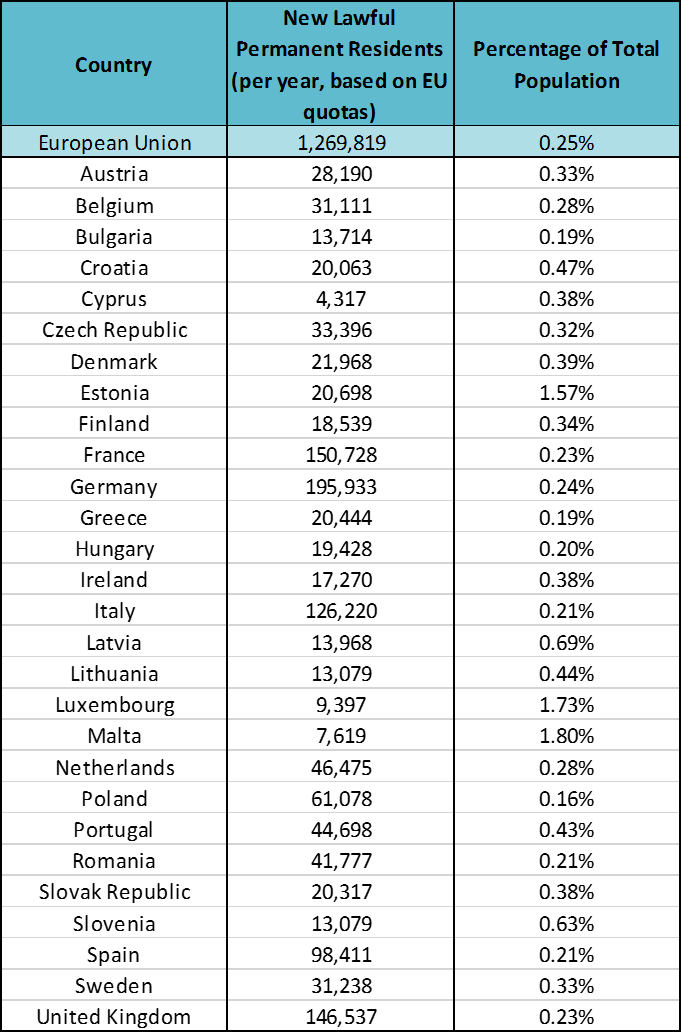What can Europe learn from the US green card system?
Stay up to date:
United States
The United States grants permanent lawful resident status [1]—with benefits similar to full citizenship save the right to vote—to approximately one million immigrants every year. Could Europe do the same?
An immigrant can obtain lawful permanent resident status in the US (i.e. receive a “green card”) through family, employment, refugee or asylee status, or other specific and exceptional conditions. Once immigrants are granted status, they have it for life, as long as they do not leave the US for an extended period or commit a serious crime. They can travel freely outside the United States, work for any US company or start their own, get social security benefits upon retirement if they have worked for more than 10 years, and petition for their spouses and children under the age of 21 to receive green card status. Above all, they can apply for full US citizenship just five years after receiving a green card.
The largest portion of newly issued green cards goes to family members of US citizens or direct family members of permanent residents (65% in 2013) [2], and a smaller but nevertheless substantial portion is obtained through employment (about 16% in 2013, which is about 160 000 people). Remarkably, approximately 12% (about 120 000 in 2013) of new lawful permanent residents each year are former asylees or refugees.
Source: Yearbook of Immigration Statistics, US Department of Homeland Security
If the EU were to accept a comparable number of immigrants, how many immigrants would it have to grant lawful permanent residency each year? The two regions obviously differ in their capacity to accept immigrants permanently, and any comparison should reflect these differences.
There is no commonly used measure for a country’s immigration absorption capacity. But let us consider the criteria used by the European Commission to set its quotas for the current wave of immigrants. It accounts for differences in demographics, economic size and immigration history between regions. The European Commission outlined the following criteria:
- the size of the population (40%) as it reflects the capacity to absorb a certain number of refugees;
- total GDP (40%) as it reflects the absolute wealth of a country and is thus indicative for the capacity of an economy to absorb and integrate refugees;
- unemployment rate (10%) as an indicator reflecting the capacity to integrate refugees.
- average number of spontaneous asylum applications and the number of resettled refugees per 1 million inhabitants over the period 2010-2014 (10%) as it reflects the efforts made by an economy in the recent past; [3]
These criteria are, as the Commission itself states, objective, quantifiable, and verifiable criteria that reflect the capacity of each individual EU member country to absorb and integrate refugees, with weighting factors reflecting the relative importance of each criteria. We use these criteria and their weights here for the EU as a whole (rather than for each individual country) to find the number of lawful permanent residency statuses the EU would have to grant in order to be comparable with the US.
Source: Bruegel calculations
Using the European quota rule, we find that the EU should grant permanent residency status to about 1 267 000 individuals per year, if it is to accept “as many” immigrants as the US. Note that this number represents only 0.25% of the total EU population. If the EU were to grant the same portion (i.e. 12%) of statuses to asylees and refugees as the US, it would have to grant status to 152 400 refugees and asylees per year (a mere 0.03% of the total EU population).
Say we determined the comparable number of immigrants the EU should absorb using only population (see the “based on population” row in the table above). The population of the United States was approximately 316 million in 2013 (Source: US Census, United States Census Bureau). If the European Union (with its population at 507 million in that year) had accepted a comparable number of immigrants as permanent residents, it would have had to grant status to about 1.6 million people (0.3% of its total population) in 2013 alone. Of this number, 190 245 would have gone to refugees and asylees (which still amounts to less than 0.04% of the total EU population).
Now consider unemployment as the only factor. The high unemployment rate in the EU relative to the US is the most restrictive criteria for calculating Europe’s equivalent green card numbers, as can be seen in the low numbers in the “based on unemployment” row in the table above. Despite this, the EU would have to accept 954 183 immigrants (114 502 of which would be refugees).
Do these numbers suggest the EU could do more for immigrants? According to Eurostat, the EU awarded citizenship to 871 300 foreigners in 2013 [4]. That leaves ample room for awarding more permanent resident statuses, even if we put more weight on less favourable criteria, such as unemployment, in the calculations above.
The current discussion remains limited to how to provide immigrants with temporary status. Just yesterday, President Juncker announced in his State of the Union address that the EU would accept another 120 000 migrants in addition to the 40 000 the Commission previously promised to relocate. Even if we add 160 000 to the average yearly number of permanent citizenships awarded in the EU to foreigners, the sum is still substantially below US green card numbers. Not only do we have enough room to allow more refugees into Europe, the data suggests we have enough room to grant them permanent stay.
The following table shows, for every EU member country, how many permanent residents it would have to absorb out of the total 1.27 million immigrants the EU should have accepted in 2013, as calculated above. To determine each country’s share, we apply the EU quota rule designed to relocate the current wave of immigrants to each EU country (see above) [5]. The last column shows the number of immigrants each country should accept as a percentage of its population. With the exception of Estonia, Malta, and Luxembourg, none of the EU countries would need to accept more than 1% of its population. On average, a country would have to take in only another 0.25% of its population in immigrants.
Source: Bruegel calculations
This benchmarking exercise with US green card data suggests that if the EU would want to be as accommodating as the US (even after taking into account differences in absorptive capacity between the two regions), there is still plenty of room in the EU to absorb more immigrants—not only in the short-term but as permanent residents.
The EU can choose for itself how many immigrants it will accept in the future. It can choose whether to be more or less accommodating than the US. However, it should consider its true capacity for immigration in making its decision.
[1] Note that this blog does not consider temporary visa permits or illegal immigration. Rather, it considers the potential for permanent EU immigration policies.
[2] This statistic includes family sponsored preferences (21%) and immediate relatives of US citizens (44%).
[3] For the last criterion, there are no comparable data available for the US and the EU. We instead use the total number of citizenships allocated to foreigners in the period 2009-2013. If we omit the last criterion and make the calculations with only the first three (with weights being 45%, 45%, and 10%, respectively) that would give us 1 282 131 total green cards and 153 856 green cards given to asylees and refugees.
[4] Eurostat also publishes statistics on first residency permits and the number of asylum seekers per EU country, but these are all non-permanent permits. These statistics show that the EU allowed 2 500 000 first residency permits in 2013. 431 000 asylum seekers were registered in 2013, about 45% of which were granted a permit (which is always non-permanent).
[5] See the communication on the European agenda on migration (annex) for each country’s key.
This article originally appeared on Bruegel Blog, the Brussels-based think tank. Publication does not imply endorsement of views by the World Economic Forum.
To keep up with the Agenda subscribe to our weekly newsletter.
Author: Grace Choi, an American citizen born in South Korea, joined Bruegel for the summer of 2015 as a research intern. Prof Dr. Reinhilde Veugelers is a full professor at KULeuven (BE) at the Department of Management, Strategy and Innovation.
Image: The United States Federal Reserve Board building is shown behind security barriers in Washington. REUTERS/Gary Cameron.
Don't miss any update on this topic
Create a free account and access your personalized content collection with our latest publications and analyses.
License and Republishing
World Economic Forum articles may be republished in accordance with the Creative Commons Attribution-NonCommercial-NoDerivatives 4.0 International Public License, and in accordance with our Terms of Use.
The views expressed in this article are those of the author alone and not the World Economic Forum.
Related topics:
Forum Stories newsletter
Bringing you weekly curated insights and analysis on the global issues that matter.
More on Geo-Economics and PoliticsSee all
John Letzing
July 3, 2025
Abdulla bin Adel Fakhro
June 30, 2025
Spencer Feingold
June 25, 2025








